
Standard 2-pin bayonet cap (left) and 3-pin bayonet cap BC3 (right) fittings compared
Summary for mystified international readers: In the UK new houses/flats must, by law, have a number of light fittings which will ‘not accept incandescent filament bulbs’ (a ‘green’ idea). This has led to the development of a proprietary, arbitrary format of compact fluorescent bulb, the BC3, which costs a lot more than standard compact fluorescents, is difficult to obtain, and about which the public generally doesn’t know much (yet). If you’re so minded, it’s not hard to modify the fitting and save money.
A lot of visitors have found this blog recently via searching for information on the MEM BC3 3-pin bayonet compact fluorescent bulbs, where to get them, and why they’re so expensive. The main posts here discussing them, with background to what it’s all about, are A bright idea? and some more thoughts – and it’s readers’ comments which are the really interesting part of both posts.
There are so many stories of frustration there, of people trying to ‘do their bit’ for the environment, trying to fit better CFLs in their homes, and finding that instead of instead of the subsidised or even free standard 2-pin bayonet CFLs available all over the place in a variety of improved designs, styles and quality, they’re locked in to having to pay 10 or 15 times as much for a BC3 bulb, and order online, simply because the manufacturer has a monopoly, and does not seem to supply the bulbs to normal DIY or hardware stores.
Frankly, the system is appalling, an example of exactly how not to design for sustainable behaviour. It’s a great ‘format lock-in’ case study for my research, but a pretty pathetic attempt to ‘design out’ the ‘risk’ of the public retro-fitting incandescent bulbs in new homes. This is the heavy-handed side of the legislation-ecodesign nexus, and it’s clearly not the way forward. Trust the UK to have pushed ahead with it without any thought of user experience.
One of the most egregious aspects for me is the way that Eaton’s MEMLITE BC3 promotional material presents users with, effectively, a false dichotomy between the ‘energy saving BC3’ and the energy-hungry GLS incandescent filament tungsten bulbs, as if these are the only two options available. There is no mention at all of standard 2-pin bayonet CFLs which have all the advantages of the BC3 with none of the disadvantages. The adoption of CFLs has been, I would argue, in large part because they are widely available as drop-in replacements for standard 2-pin bayonet (or Edison screw) bulbs. If they’d all required special fittings, very few people would have bought them.
Anyway, if you don’t fancy swapping your BC3 fittings for standard 2-pin bayonet ones (which is cheap but would(?) presumably make your home non-compliant with part L of the building regulations – any knowledgeable readers able to clarify this?), it isn’t actually too difficult to get a 2-pin bulb to fit acceptably. You will need a pair of pliers, ideally thinner/longer-nosed than the ones in my photos. I should warn you to TURN OFF THE ELECTRICITY FIRST. Unless you’re absolutely sure that someone else won’t walk in and flip the light switch, don’t rely on just turning this off. Turn it all off at the main switch for the house.
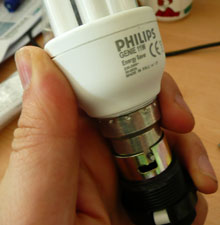
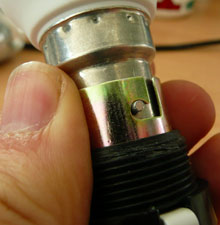
Here (above) is a Philips Genie 11W 2-pin bayonet CFL. It fits properly into a 2-pin bayonet fitting. When you try to fit it into the BC3 fitting (below), one of the pins will go into one of the J-slots OK, but due to the offset of the other slots, the other pin won’t go in. Ignore the third slot.
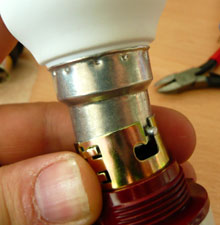

But if you look carefully at how the non-fitting pin lines up with the slot (below), you can see that the bottom end of the slot, i.e. where the pin would sit if it could be got into the top of the J, is (just) to the left of the pin. (See the line I scratched on the fitting.) That is, if you could get it there, it would still sit in place without immediately falling out.
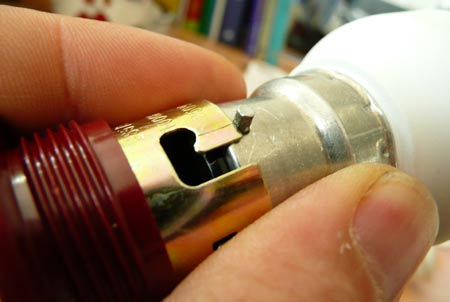
So, with the pliers (making sure the electricity really is off), bend the edge of the non-fitting slot (the inside edge of the J) inwards and fold it back on itself, squeezing it as tight as you can (below two photos):
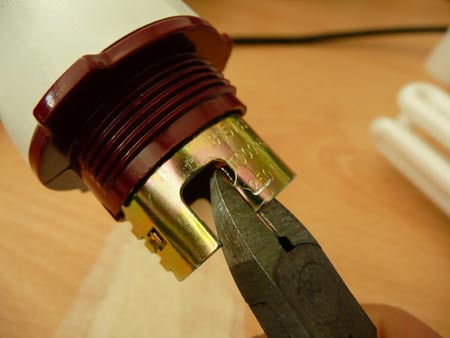
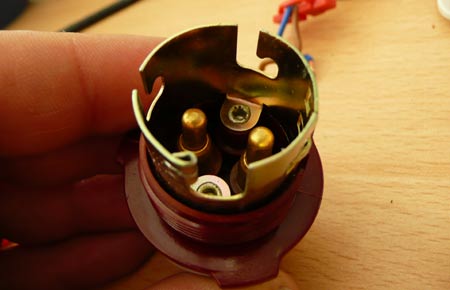
Now try the 2-pin bayonet bulb again (below) – it should fit OK, with a bit of wobbling perhaps. One pin should fit under the bit you just bent; the other should butt up against the inside corner of the J on the other side. It’s not perfect, but the friction there is enough to hold the bulb in place OK.
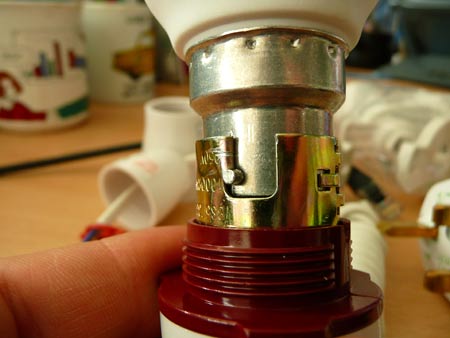
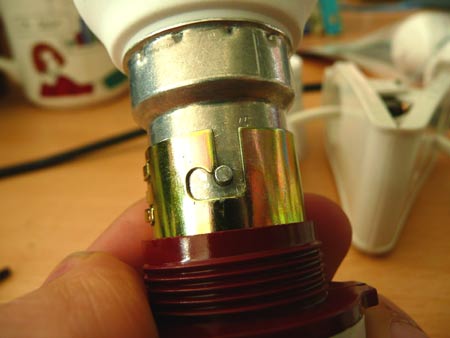
Switch on the electricity again, and there you have it: any standard 2-pin bayonet bulb, working, in a BC3 fitting (below). Given the amount of free CFLs handed out by various organisations, you could probably replace all the BC3 bulbs in your house for zero cost, once they come to the end of their lives.
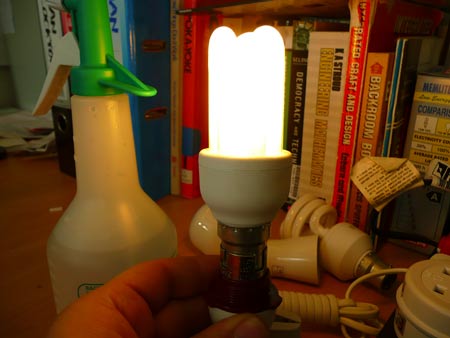
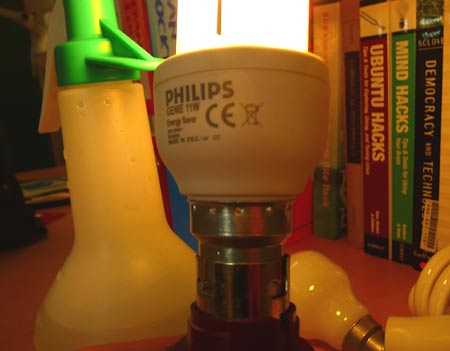
Disclaimer: I can’t accept any responsibility for injuries, non-compliance with building regs, incidental damage, etc. The above is just a proof of concept, etc. Have fun.
How to fit a normal bulb in a BC3 fitting and save £10 per bulb
Arbitrary, Architecture & urbanism, Bad design, Bad profits, Blog, Britain, Bureaucracy, Business model, Circumvention, Consumer rights, Design, Design with Intent, Do artifacts have politics?, Environmental, Fightback Devices, Freedom to tinker, Intrusive technology, Legislation, Lock-in, Monopoly, Political design, Propaganda, Rent-seeking, Sustainability, Technical protection measures, Technology policy, User experience

Pingback: rascunho » Blog Archive » links for 2008-07-22
Pingback: Frankie Roberto – Designing with Intent with Dan Lockton
Pingback: 3 Pin Lightbulbs, Consumer Concerns « Greener Power
Pingback: Lightmate adaptor for low energy pendants - Electricians Forum | Electrical Advice Forum | An electrical forum for electricians in the UK
Pingback: Light Bulb, Special BC3 Base, CFL 3-Pin Adapter, Memlight Ripp-off | Technical Tips
Pingback: Singer 1933 Catalogue and Price List (UK) « oldsingersewingmachineblog